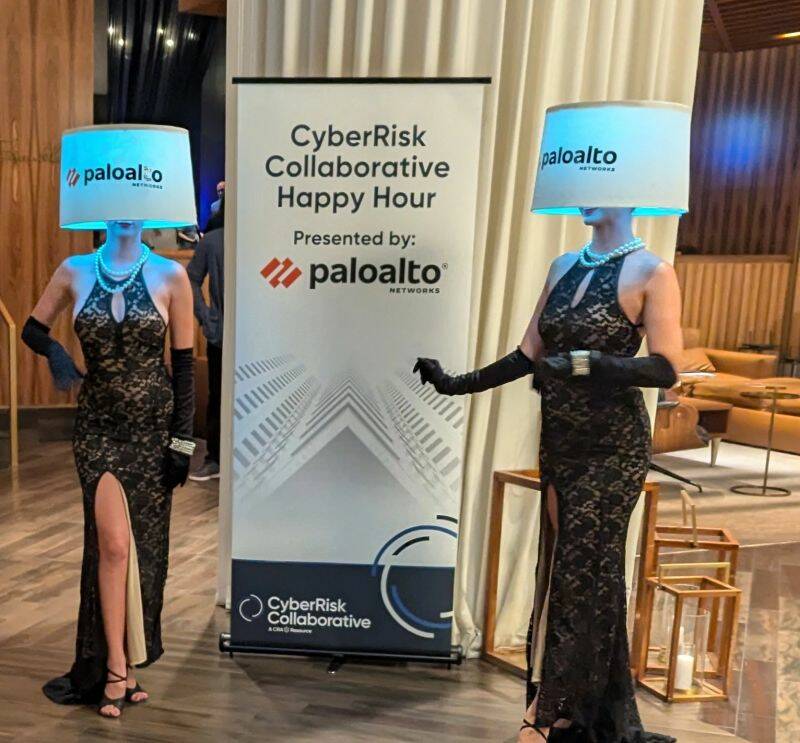If you attended the Black Hat conference in Vegas last week and found yourself over in Palo Alto Networks’ corner of the event, you may have encountered a marketing gimmick that has since been heavily criticized for misogyny.
Security architect Sean Juroviesky’s LinkedIn post and accompanying image, which was subsequently shared by equally outraged conference delegates, attracted scores of angry cybersecurity pros all demanding answers from Palo Alto Networks (PAN).
Why? The cybersecurity giant paid women – and only women – to stand at the entrance to its happy hour networking event dressed up as illuminated human lamps. Their faces were obscured by actual lampshades.
Palo Alto’s Black Hat booth. Pic: courtesy security architect Sean Juroviesky
Juroviesky felt the need to point out that these weren’t wax figures which some people may assume to be the case. These were real women, with their faces replaced by a PAN-branded lampshade. Only their bodies could be seen, clothed in tight dresses.
Apology central
PAN’s chief marketing officer Unnikrishnan KP, or Unni as he’s often called, issued his apology earlier this week calling it “tone deaf.”
“Last week at Black Hat in Las Vegas, an unfortunate decision was made at a Palo Alto Networks event to have hostesses wear branded lampshades on their heads,” he said. “It was tone-deaf, in poor taste, and not aligned with our company values or brand campaign.
“I take full responsibility for this misjudgment and have addressed it with my team and am taking steps to prevent such misguided actions in the future.
“Please accept my heartfelt apologies for this regrettable incident.”
Nikesh Arora, PAN’s chairman and CEO, doubled down on the apologies on Tuesday, echoing the points made by Unni, adding that what happened was “unacceptable.”
“To our community, customers, partners, and colleagues, let me begin with a sincere apology for a recent marketing decision at an event hosted by Palo Alto Networks during Black Hat in Las Vegas,” he said in an open letter.
“The misguided attempt to welcome guests with branded lampshade-wearing hostesses was not consistent with our values. I appreciate you not judging us on this isolated event, and I want to reassure you of our continued commitment to and celebration of inclusion and diversity.
“Let me be clear: what occurred was unacceptable. We could have, and should have, done better. We will do better.”
Arora went on to say that the company investigated the “root cause” of the issue and addressed it with the event team and the entire marketing unit. PAN reinforced its brand representation guidelines in line with its diversity and inclusion principles, and has imposed what it calls “an enhanced management review of all external-facing brand representations until further notice.”
“We deeply appreciate your understanding and thoughtful consideration in this matter,” he added.
PAN co-hosted the networking event with business intelligence brand CyberRisk Collaborative, which also apologized for the incident. It said it was only made aware of the human lamp decision when its team members arrived at the Happy Hour and distanced itself by adding that it had no role in planning the networking event.
Beyond the executives’ statements provided to us by PAN’s PR specialists, we were told we shouldn’t expect any more input on the matter from the company.
Olivia Rose, veteran global CISO, who has worked at Mailchimp, IBM, Avaya and other organizations during her career, said on LinkedIn:
“Palo Alto should also be made aware that I have personally received multiple messages from women at the company who were too scared to speak up about this decision. Quite a Bro Culture going on there, sounds like.”
“So we women are nothing more than props to you? We are only at BlackHat to be lampshade holders?? Are those intended to represent bright ideas inside our heads or… just light bulbs? Shame on you. Just shame.”
Almost 1,850 people liked her post and hundreds of comments were generated. Among them, Samantha Wall, a digital strategist, said of the lampshade wearing women:
“They’re made to look like static manikins, where all that matters is their curvaceous bodies. They may look great at a ball but not motionless either side of a business event banner!! What the hell!?”
Another poster said: “Professional performing artist speaking – The way to make this Art and not objectification would have been to have both female & male “live statues” & probably to watch to not ‘over-undress’ either. Or put another way: making something that wasn’t aimed to please the ‘male gaze’ (ask chatgpt or google if that term is new to you…) but rather was aimed at showing respect & equality alongside creativity.
“As a pro artist I love the surreal meeting the real. I love humans being shapes & inanimate objects being personified in all sorts of physical theatre and movement settings. But as a woman in Tech knowing the context & industry background here, this execution is saddening and problematic.” ®

